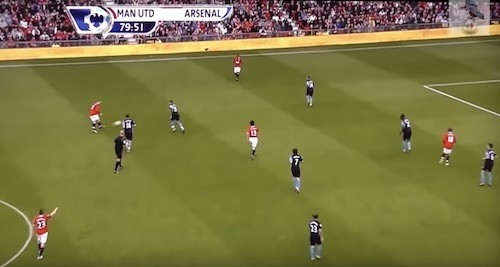Soccer runs: How do you move off the ball and make runs in soccer? What’s interesting is you don’t always have to run or move. If you watch Messi play he sometimes is hiding out or walking into the space he wants to occupy so he can open up the game for others or sneak into a good position. Making runs in soccer is a lot about timing and your overall positioning on the field.
The important thing to remember is to make runs that lead to goal scoring opportunities or to open up space for a teammate. And as with dribbling, often soccer runs are all about change of pace. Lulling the defender into thinking you’re slowing down and then make a darting run.
If you make a run in behind the defense, for example, and that doesn’t work out, check back to the ball, get the ball and lay it off and then make that run behind the defender again, so the midfielder can chip or loft the ball to you in the air. Or, if the midfielder on the left side has the ball, you (as the center midfielder) can make a run down the line to receive the ball or open up space for the left sided midfielder to take his opponent on the dribble and move into the open space in the middle. Movement off the ball opens spaces for your teammates.
If there’s an opportunity to take the defender on, go for it. If not, lay it back to the center midfielder and break down the line again to receive the ball. The center midfielder can also make an overlapping run. The right sided midfielder can play a one two with the forward who is posting up. There are numerous options if everyone on the field is looking to put themselves into position to receive the ball and help one another.
Perfect Your Soccer Runs
To execute these types of exchanges (a give and go or overlap) you need to lead the defense into believing you are going in a different direction. Keep them on their heels; lay the ball off at the right time. You can always start over. If one side of the soccer field is too clogged up and crowded, then switch the ball to the other side. It could be two square exchanges of the ball and then on the third pass, someone breaks into the open space to receive the ball in behind the defense.
There’s nothing wrong with sending the ball back to the keeper if you’re under too much pressure. Of course, you have to make sure the keeper has enough time to clear the ball or play the ball to an open player. But many top teams, when under too much pressure, will knock the ball back to the keeper who will blast the ball up towards their center forward.
Starting over can also mean making a run to get yourself open or setting up your defender for a return pass. Dart down the line, checking back to get the soccer ball. Make an angled run into the middle, then checking to the outside. Essentially, this is making space for yourself by taking the defender with you into the middle and then breaking to the outside, where you really want the ball. Draw the defender away from the space you want to receive the ball in – and then check back into the space you just opened up. It could even just be walking five yards towards the sideline and then breaking back to the middle.
Check back to the ball at an angle. This way you will have more space in which to turn and see the field, as your body is already half turned. You can check back to the ball side on so you can see where you want to play the ball next, and keep your body between you and the defender (control the ball with the outside of your foot, for instance). The key is taking a look before you receive the ball so you know if you can turn or if there’s a man on.
At the same time though, your teammates must let you know if you have time or send you a message by the weight of the pass. If the ball is played in a crisp pace, that usually means there’s a man on. If the ball is played more softly, then you have time to turn. But again, players must let one another know if they can turn or they are under pressure.
Making Runs & The Killer Pass
When you watch Manchester United, Barcelona, or Real Madrid play you’re probably amazed at their ability to keep possession of the ball. Especially since all these teams hold on to the ball so well, at each position, from the forwards to the defenders. And even the keepers have impressive foot skills – many could play in the field for other teams. Iker Casillas, he might be able to play forward in the MLS. Just kidding.
But what sets these teams apart from other teams is underneath that calm, cool, and collected nature on the ball is a ruthlessness. They want to win and they want to score. When there’s an advantage, say a chance for numbers up or a counter attack, they will pounce on it. If your central defender pushes up into the attack and loses the ball, watch out, they will go right at that newly opened space in the middle.
Besides a numbers advantage though, in general, how do they do they score goals and win games? Their players make decisive runs in behind the defense. They might knock the ball around twenty times, but the whole time they’re looking to play that killer pass.
However, they need players to make dangerous runs in order to play those passes. If a deep central midfielder blasts up the field and sneaks unseen through the defense, Ryan Giggs can play the ball through and give that player a chance to score. If Pedro cuts in from a wide area behind the defender, Iniesta can slip the ball through and put him one on one with the keeper. Making runs and the killer pass are inseparable. There isn’t one without the other.
Players are constantly darting in and out of spaces, testing the other team, seeing if they can sneak in behind the defense. And the midfield playmakers are always on their toes, looking to pick them out with a killer pass. Learn more about how to make runs in soccer, positioning and movement.















